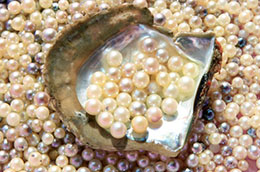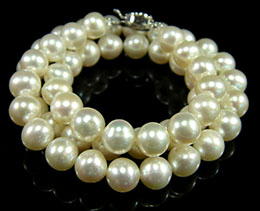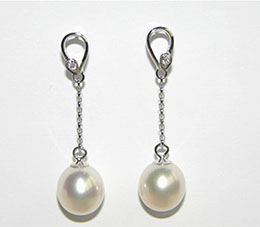What are Cultured Pearls

Cultured pearls are created by the same process as natural pearls. That is, they result from the introduction of an irritant inside the shell of certain types of mollusks (i.e., oysters, clams, etc.). The difference is that, in the case of cultured pearls, the irritant is inserted rather than being naturally occurring. Natural pearls are caused by a grain of sand or something of similar size. Cultured pearls generally start with a much larger irritant (relative to a grain of sand), but it still takes two to three years for the pearl to be created after the insertion of the irritant. Freshwater cultural pearls don’t require an irritant; these are created by making a small slit on the inside lining of the mollusk.

Natural pearls are extremely rare; the major consumers of these pearls are collectors. It is possible to find natural pearl jewelry, but most pearl jewelry sold today is made with cultured pearls. Cultured pearls jewelry is not inexpensive. Cultured pearls are authentic pearls and so are judged and priced similar to the way authentic gemstones like diamonds are judged and priced. Generally, saltwater pearls are more expensive than freshwater, but certain types of freshwater cultured pearls are gaining in popularity.
The only reliable way to differentiate between natural and cultured pearls is by X-ray, as the only practical difference between the two types of pearls is their interior structure. However, it is possible to determine whether a pearl is real (natural or cultural) or imitation by rubbing the pearl against your teeth. Natural/cultured pearls will feel gritty, while imitation pearls feel slick. Note that imitation pearls are just that – made of other materials like plastic or glass and designed to simulate the appearance of real pearls.

Cultured pearls require the same care as natural pearls. Jewelry made from either type of real pearl should be handled with care. Most experts suggest avoiding chemical jewelry cleaners for pearl jewelry, as they can cause damage to the surface of the pearls. Mild soap and water is generally recommended for cleaning, if it’s necessary. Real pearls can also be scratched easily, so it’s better to store them separately. Pearl strands, which are pearls strung together on either silk or nylon with knots between each pearl, should be inspected periodically and will require re-stringing after a certain amount of wear.
To sum up, cultured pearls are real pearls. They are harvested, not manufactured. Cultured pearls require the same type of care as natural pearls. Imitation pearls are artificial and are completely man-made while cultured pearls are made by mollusks, with a little help from mankind.

Comment (0)